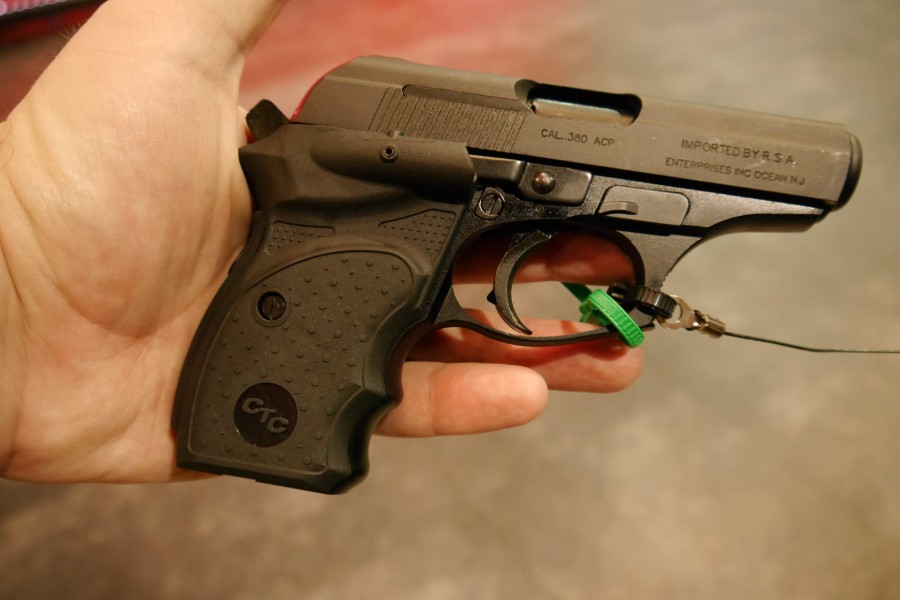Crimson Trace is best known for their eponymous red lasers, but they have been steadily branching out into green lasers as well. The power hungry and clunky green diodes have been a problem, but it looks like CT has finally made it economically viable to put green lasers into the same packages as the existing red lasers. The one I’m most excited about is the Rail Master, a standalone laser device that slots onto any available rail. Also in the works are green lasergrips for a bunch more guns, including . . .
The Bersa Thunder. Apparently there’s a huge demand for lasergrips for the Bersa Thunder, as there’s also a large number of people carrying the gun for personal protection. Not necessarily my cup of tea, but nice to see that CT is responding to public demand.






The problem with laser grips for the Bersa Thunder is that even the cheaper red laser grips from Crimson Trace cost more than the gun.
Can you go back an ask them to “IR Everything”?
We need some really good IR laser grip options. The ones they offer are… sparse. And they already make them for mil/leo, but they don’t offer them to the rest of us.
No idea why most of the IR offerings are MIL/LEO only. I can guess — but there’s surely no law about it. Every IR offering I’ve seen has had restricted sales. It’s not expense — IR diodes are cheaper than red to procure.
It *might* have to do with export…
Understood…
And the law looks to be the ‘International Trafficking in Arms Regulations”. Collectively known as “ITAR restriction”.
http://en.wikipedia.org/wiki/International_Traffic_in_Arms_Regulations
So, yeah, it looks like there is a law.
79 FR 77884 – Amendment to the International Traffic in Arms Regulations: United States Munitions List Category XI (Military Electronics)
http://www.law.cornell.edu/cfr/text/22/chapter-I/subchapter-M
Green is so much brighter than red, especially outdoors.
For those without rails, and who like their grips, there are also rail-guards. The rail guards are good, my only complaint is the on-off switch, which is
tinymicroscopic. Hard to turn on/off one handed. Added plus is that the weight reduces muzzle flip.… there are even holsters that accommodate the grips and guards.
I’ve got a Rail Master 203 on a Sig P226 in .40 S&W. I really like it. It is easy to mount, easy to adjust and easy to use. Their activation system is simple and works great. I bought a holster for it from Vega Holsters that adjusts to fit the Laser slung under the Barrel nicely.
Actually, this is probably because single-stage green diodes have just recently become viable and affordable. So I’m guessing that’s what’s going on here.
Until last year (really, that recently) – all green lasers used frequency doubling crystals in front of infrared lasers. These were hard to make small, power efficient, and durable. Their power, heat dissipation and footprint requirements (and cost) were much more than their red cousins until now.
Now that “native” green diodes are happening, it’s a LOT easier for companies like Crimson Trace to put green into something that’ll fit on a firearm frame, stand up to a lot of abuse, and be cost effective. (Basically the exact same electronics and mechanics that were used in the older red diode models can now be used in the green ones.)
So this doesn’t surprise me, and is really cool. The human eye is WAY more sensitive to green than red. This also means longer battery life than red for even greater brightness.
(Disclosure: Aside from firearms and signals, I’m a DIY laser hobbyist.)
It’s funny that I’m typing this as I’m replacing the batteries *again* in the green Viridian sight on my LCP.
Does your explanation of the way the older green lasers worked also explain why they have a significantly narrower temperature operating range? While the red lasers were good from about -40 F to 120 F, the green lasers were only rated for 32 F to 104 F (less than half the temperature span of the red laser). In my area (extreme northern plains), that means outdoor use of a green laser is restricted by temperature (on one end of the range or the other) for potentially more than half the year.
Check the info/tech sheets for the Streamlight TLR-2 and TLR-2G laser/lights for an example (the above temperature range examples were pulled from those sheets).
If you look at the natural spectrum of ROYGBIV you see that GREEN is in the center. Just as our hearing is keyed to the midrange of 1-10k hz our eyes are keyed to see green better. That is also why in bush wars our guys have so much trouble because Asia and Central America are a riot of green.
Human ears are most sensitive to about 1Khz, not surprisingly the neighborhood of an infant’s cries.
Am I correct in thinking that green lasers use more battery?
See Michelle’s explanation above. The early double-pumped diodes were very inefficient.
Leghorn,
Is anyone doing native green lasers? This is an important question. If they are, then battery life and temperature range issues should be much improved. If they are not, then the questions are why and when.
Love Crimson Trace. I have them on 8 handguns and 4 rifles. The green will do 50 yds but you really have to look hard in the sun. The red only about 10 yds. They are a great company and I’m lucky to live several minutes from them. When I need a new battery I just stop by.
Comments are closed.